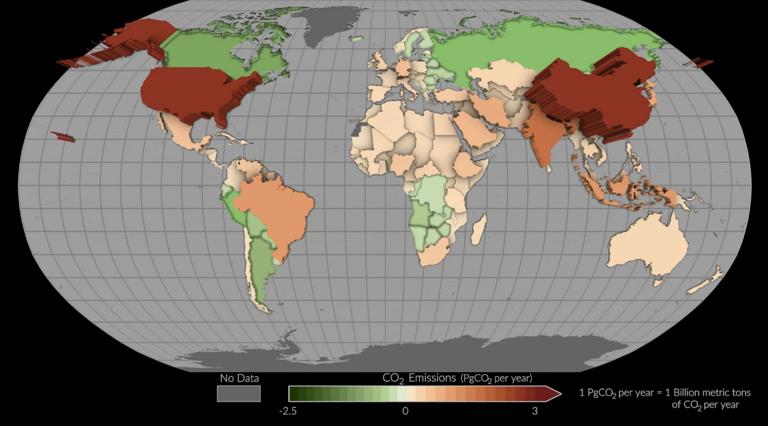A NASA Earth-observing satellite has helped researchers track carbon dioxide emissions for more than 100 countries around the world. The pilot project offers a powerful new look at the carbon dioxide being emitted in these countries and how much of it is removed from the atmosphere by forests and other carbon-absorbing “sinks” within their borders. The findings demonstrate how space-based tools can support insights on Earth as nations work to achieve climate goals.

The international study, conducted by more than 60 researchers, used measurements made by NASA’s Orbiting Carbon Observatory-2 (OCO-2) mission, as well as a network of surface-based observations, to quantify increases and decreases in atmospheric carbon dioxide concentrations from 2015 to 2020. Using this measurement-based (or “top-down”) approach, the researchers were then able to infer the balance of how much carbon dioxide was emitted and removed.
Although the OCO-2 mission was not specifically designed to estimate emissions from individual nations, the findings from the 100-plus countries come at an opportune time. The first Global Stocktake – a process to assess the world’s collective progress toward limiting global warming, as specified in the 2015 Paris Agreement – takes place in 2023.
“NASA is focused on delivering Earth science data that addresses real-world climate challenges – like helping governments around the world measure the impact of their carbon mitigation efforts,” said Karen St. Germain, director of NASA’s Earth Science Division at NASA Headquarters in Washington. “This is one example of how NASA is developing and enhancing efforts to measure carbon emissions in a way that meets user needs.”
This is why developing a database of emissions and removals via a top-down approach could be especially helpful for nations that lack traditional resources for inventory development, the study authors assert. In fact, the scientists’ findings include data for more than 50 countries that have not reported emissions for at least the past 10 years.
The study provides a new perspective by tracking both fossil fuel emissions and the total carbon “stock” changes in ecosystems, including trees, shrubs, and soils. The data is particularly useful for tracking carbon dioxide fluctuations related to land cover change. Emissions from deforestation alone make up a disproportionate amount of total carbon output in the Global South, which encompasses regions of Latin America, Asia, Africa, and Oceania. In other parts of the world, the findings indicate some reductions in atmospheric carbon concentrations via improved land stewardship and reforestation.
The study offers a complex picture of carbon moving through Earth’s land, ocean, and atmosphere.
In addition to direct human impacts accounted for by national inventories, unmanaged ecosystems like some tropical and boreal forests – where humans have a minimal footprint – can sequester carbon from the atmosphere, thus reducing potential global warming.
Sources:
NASA
Provided by the IKCEST Disaster Risk Reduction Knowledge Service System
Comment list ( 0 )
